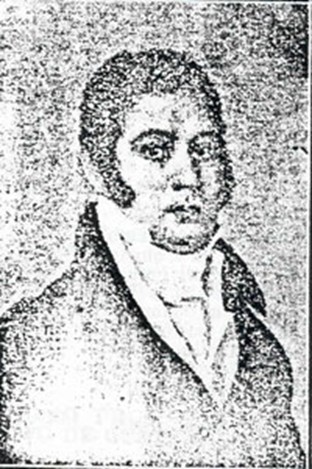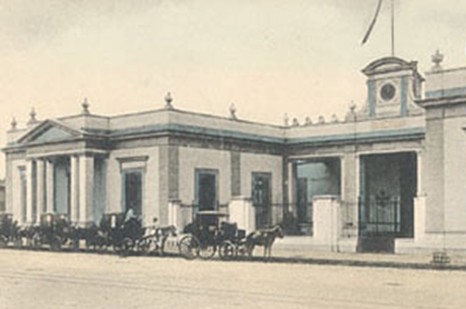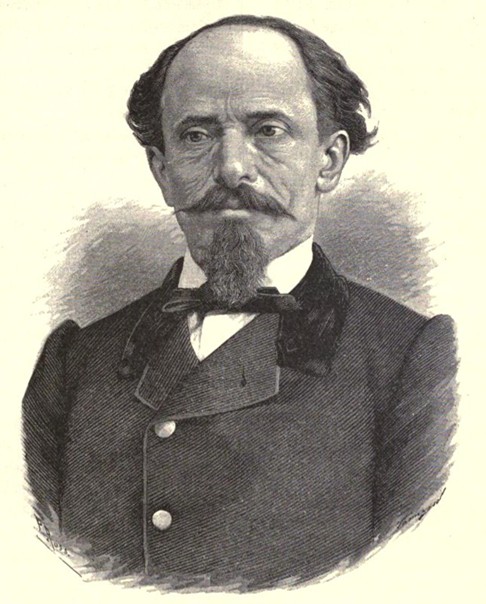[Link to “Surprising History in Yucatán” — Introduction to the Series]
Governor, president, senator, general, judge, hero, traitor, conservative, liberal, doctor, lawyer, scholar…. The O’Horán family was there through the entire tumultuous history of nineteenth-century Yucatán, deeply immersed, in so many important ways.
This thoroughly Yucatecan family with a very un-Spanish name arrived in the Peninsula in 1760. Juan José de O’Horán y Ready was a native of the rural district of Aughane in County Cork, Ireland. He grew up in the Canary Islands, where his parents, John O’Horan and Jane Ready, moved when their son was young. Many ambitious Irish were emigrating during this period, and Spain and its American possessions were popular destinations.
Juan de O’Horán quickly made himself at home in Campeche. In 1762, he married a local woman, María Gertrudis de Argüello y Monte, and they raised a family of seven children, three boys and four girls. Two of the sons, Tomás Antonio and Diego, made significant marks in history, about which we shall learn more. We know almost nothing of the middle son, Pablo, or of the daughters, Rita, Teresa, María Ana, and Juana Gertrudis.
One can only regret the lack of historical information about women in the period and, indeed, until recent times. The stories of the capable women who were surely part of this family have been lost to us. With that inadequate apology, let us proceed to consider the youngest son of this first generation, Diego.
Diego O’Horán y Argüello
Diego Manuel José O’Horán y Argüello was born in Campeche in 1773. Like both of his brothers, he attended the Seminario Conciliar de San Ildefonso in Mérida, the only institute of higher learning in Yucatán at the time. Diego took orders as a priest in 1795 and taught Latin, moral theology, and philosophy at the seminary. He acquired a reputation as a staunch conservative.
One of Diego O’Horán’s students was Lorenzo de Zavala, who became an outstanding liberal statesman in the era of early Mexican independence and unlikely vice president of the Republic of Texas. (Zavala was the subject of articles in this series published in February and March 2015.)
Diego left teaching in 1802 to become vice-rector of the seminary. He earned recognition as a leader of the conservative political faction known as Rutineros. He spoke eloquently in support of continuing loyalty to the Spanish Crown and against the constitutional reforms of 1812. In direct opposition, Zavala became a leader of the Sanjuanistas, Yucatecans working to increase democracy and freedom of expression.
Diego and his conservative ideas eventually lost the contest. The Captaincy General of Yucatán joined the Viceroyalty of New Spain in the independent Mexican Empire. But conservatism was deeply rooted in the stony soil of Yucatán and persisted in a long and sometimes violent contest for supremacy during the next century.
Diego O’Horán finished life as parish priest in Valladolid, where he died in 1821, the year of Mexican independence.
Tomás Antonio O’Horán y Argüello
The eldest son of Juan José and María Gertrudis was Tomás Antonio de los Santos Mártires Juan y Pablo O’Horán y Argüello, born in Campeche in 1763. (We will call him Tomás Antonio to avoid the confusion with his son, also named Tomás, often found in the literature.) Tomás Antonio worked at various nondescript jobs until, at age 31, he decided to further his education. He learned Latin and philosophy at the Seminario Conciliar, then studied law at the Colegio Real de San Ildefonso in Mexico City. He proved to be a brilliant student and graduated with honors.
As a new lawyer, he took a position with the Royal Audencia of New Spain. He served with distinction as financial auditor and law counselor in Veracruz. In 1817, he received a fateful assignment to audit the accounts of Pedro Manuel Escudero de la Rocha, Treasurer of the Royal Audencia in Campeche. He found don Pedro’s accounts in order and his daughter, a 19-year-old beauty named Gertrudis, charming. The couple contracted to be married, setting the date for December 13th.
In November Tomás Antonio learned he was to receive a promotion that required his immediate presence at the Court in Madrid. He asked that, in his absence, the wedding go ahead as planned and gave Pedro Escudero permission to act as his proxy. The absentee wedding took place with the bride’s father standing in for the groom.
In January 1818, Tomás Antonio returned to Campeche for a reunion with his bride. In April the couple traveled to his new assignment with the Royal Audencia in the Captaincy General of Guatemala. His position as judge and auditor afforded them a fine two-story mansion on the main plaza in Nueva Guatemala de la Asunción (Guatemala City).

Tomás Antonio O’Horán Argüello (1776-1848) Miniature portrait, probably by Rafael G. Goyena, Guatemala, ca. 1818. (From Dictionary of Irish Latin American Biography.)
The O’Horán Escudero family eventually included eight children, seven boys and one girl, born between 1818 and 1828. We shall hear more of sons Tomás, Patricio, and Agustín. As for the others, Pedro fought in Yucatán’s civil wars and José María was a lawyer, but too little is known about either to tell much of a story. We know even less of Guadalupe, Juan Manuel, and Diego.
Tomás Antonio developed friendships within a group of patriots working for Guatemalan independence. This must have placed him, as an agent of the Crown, in a difficult situation, but all apparently held him in high esteem because of his just decisions as a jurist. Members of the independence faction were in correspondence with the Sanjuanistas, his brother’s opponents in Mérida.
Guatemala achieved independence from Spain in 1821, and along with the Provinces of El Salvador, Costa Rica, Nicaragua, and Comayagua (Honduras), joined the Mexican Empire. When the Empire was overthrown two years later, the Central American provinces withdrew and formed the United Provinces of Central America. Through it all, Tomás Antonio continued his judicial work.
The leadership of the United Provinces was in the hands of a ruling council. The three members served rotating one-month terms as chairman — essentially the president of the nation. Tomás Antonio was elected a member of the triumvirate and served until April 1825, when the nation reorganized as the Federal Republic of Central America with a single president. Tomás Antonio returned to the court with universal respect and approval.
His career in Guatemala ended in October 1830 when a civil war brought General Francisco Morazán to the presidency. Tomás Antonio had made an enemy of Morazán by ruling against him in several legal cases. Morazán declared O’Horán to be a foreigner and petitioned to have him removed from office. Tomás Antonio prudently decided it was time to return to Mexico with his family.
They left in January 1831, traveled overland to Chiapas, then to San Juan Bautista (Villahermosa), and finally by schooner to Campeche. After joyous family reunions, they moved to Mérida, to a fine large house two blocks from the main square.
In February 1833, the family received an unexpected visit, which proved significant in the career of their youngest son, Agustín. A young physician from Nicaragua, Dr. Ignacio Vado Lugo, stopped by to visit Tomás Antonio, with whom he had become acquainted during the years in Guatemala. In a long evening of conversation, O’Horán convinced Vado to remain in Mérida and teach medicine. A meeting with the governor won instant support, and the School of Medicine was founded on June 10, 1833, with Vado as its first director.
Tomás Antonio was named to a commission that wrote the legal codes and procedures for Yucatán. Subsequently he became a magistrate in Mérida and represented Yucatán in the Mexican Senate.
During his government service in Mexico City, his health began to fail. Tomás Antonio O’Horán y Argüello, 85 years old, died of lung problems in Campeche on August 21, 1848, honored for his knowledge and dignity.
Tomás O’Horán Escudero
Tomás O’Horán Escudero was the eldest son of Tomás Antonio O’Horán y Argüello and Gertrudis Escudero de la Rocha. Born in Guatemala in 1819, Tomás was an authentic military hero who fought for Mexico in every conflict of his era but tragically died as a traitor.
As a 17-year-old cadet in 1836, Tomás was with the Mexican forces of Antonio López de Santa Anna fighting in Texas. He was with Santa Anna again, opposing the French in the Pastry War of 1838. The following year he was in Yucatán, a second lieutenant in command of a squadron of cavalry opposing Santiago Imán, who wanted Yucatán to secede from Mexico. Tomás defended Mexico against invaders from the United States, notably at the Battle of Buena Vista in February 1847. In the Reform War of the 1850s, he fought on the side of Benito Juárez and the Liberals.
Most notably, Tomás won fame as “the Immortal of Atlixco” during the French Intervention. On May 4, 1862, troops of the Mexican Republic commanded by Generals Tomás O’Horán and Antonio Carvajal repelled Mexican Conservative forces, preventing them from reinforcing the French invaders. This contributed significantly to the famous Republican victory at Puebla the next day, on “Cinco de Mayo.” A year later, Tomás again distinguished himself during the 62-day siege of Puebla by French General Forey. In a daring raid, Tomás broke through the siege lines and delivered desperately needed supplies to the city.
Continuing to serve the Republic, Tomás received appointments from President Juárez as military commander of Morelia and later governor and military commander of the State of Mexico. But he was stranded when the Republicans retreated and the French took over central Mexico. Finding himself out of work, without resources, and immersed in violent disorder, he accepted an appointment from the French-backed Imperial Government. As civil and military subprefect of Tlalpan, Valle de Mexico, he did a good job of bringing order to a bad situation.
But the legitimate government of Benito Juárez won. The French evacuated the capital in February 1867, and the city surrendered on June 20. Tomás O’Horán fled but was apprehended and sentenced to death as a traitor.
The Republican military commander, General Porfirio Díaz, requested a pardon because of past distinguished service by Tomás, but Juárez was implacable. Tomás wrote a last manifesto stating he was only trying to bring order to Mexicans, did not further the interests of foreigners, and did not deserve death for making a political error. He claimed he had served Mexico in eight wars and 86 battles.
General Tomás O’Horán Escudero died before a firing squad on August 21, 1867.
Patricio O’Horán Escudero
Patricio Eulogio, younger brother of Tomás, was also a military hero. Instead of fighting Mexico’s conflicts, though, he spent his career in Yucatán fighting Maya rebels in the Caste War.
We know that Patricio was born in Guatemala in 1826. We know some fragments of his military career. We know that he married Delfina Gámera y Zavala on May 1, 1852 and that they had no children. Beyond that, information is scare.
In 1847, as the Caste War was beginning, Patricio was a 2nd lieutenant in the Yucatán cavalry. He was present at several engagements near Tihosuco, including one at Xcabil, the rancho of Maya leader Jacinto Pat. Sketchy reports say Patricio distinguished himself with his daring and was wounded in action.
In 1850, now with the rank of colonel, Patricio led a noteworthy expedition that established his reputation. Leading a force of 700 men, Colonel O’Horán marched out of Tihosuco on June 27 and headed for Bacalar. Yucatecan troops had taken that remote, isolated fortress in the far southeast a year earlier in an effort to cut the Maya supply lines from Belize. But the garrison there, surrounded and besieged by the enemy, was now in a desperate situation.
The expedition passed through depopulated enemy territory, enduring attacks and hardships. They entered Bacalar on July 5, to the amazement of the fort’s defenders. With the modest relief, the garrison was able to hold out until further help arrived by sea from Sisal.
O’Horán returned by a different route, fighting skirmishes at several points and destroying enemy resources. He arrived at the forward base at Kancabchén on July 20 with 218 Maya prisoners, captured arms and livestock, and clothing stripped from 117 adversaries killed in the field.
Later we hear briefly of Colonel O’Horán in charge of a section in the Chenes region, rounding up rebels and their families from the forests. After that, Patrick vanishes from the historical records, remembered for his bold expedition to Bacalar.
Agustín O’Horán Escudero
Of all the members of the family, this youngest son of the O’Horán Escudero clan is the one we know best today, because Mérida’s large public hospital bears his name. Agustín’s story goes beyond his distinguished medical career, into the center of the complex politics of mid-century Yucatán.
Agustín Jorge O’Horán Escudero was born in Guatemala City in 1828, moved with his family to Mérida in 1831, and entered the Colegio Seminario Conciliar 1840. At age seventeen, Agustín entered the School of Medicine, founded by Dr. Ignacio Vado Lugo with the aid of his father, Tomás Antonio O’Horán y Argüello.
In 1848, when the Caste War forced a year’s interruption of classes, Agustín served as a medic with the military unit of his brother, Patricio. Agustín obtained his medical license in 1853 and a doctorate in 1855, presenting a well-received dissertation on skin rashes.
Vado died during a cholera epidemic in 1853. Young Dr. O’Horán took over his responsibilities and in 1854 was named director of the General Hospital, located on the north side of Mérida’s cathedral. Agustín earned respect for treating rich and poor alike and established a growing private medical practice. On Agustín’s recommendation, the hospital moved to larger quarters on the Plaza de la Mejorada in 1861.
During this chaotic period in Yucatán, Agustín was increasingly involved in Liberal politics. He became a close friend and personal physician to Manuel Cepeda Peraza, military commander of Yucatán under the Liberal government. When the French-led Empire took control, he resigned his official responsibilities.
With the fall of the Empire, Manuel Cepeda Peraza became governor. General Cepeda wisely recognized that he needed help with governing and named an advisory council chaired by Agustín, which essentially ran the state government.
During two periods in 1867 when Cepeda was absent, Agustín O’Horán served as provisional governor. He was slightly injured while putting down a revolt at the fortress of San Benito. To counteract conservative influences, he helped found the Literary Institute and reorganized the Teachers College to eliminate theological studies, emphasizing the need for facts and logic rather than “superstition and metaphysics.”
In 1869 Agustín reluctantly agreed to be a candidate for governor. His opponent, Manuel Cirerol y Canto, won in a blatantly rigged election marked by violence. Several prominent military leaders offered to mount an uprising in support of O’Horán, but he thoroughly discouraged it saying, “I will never ascend to power over the corpses of my brothers.”
Agustín returned to medical practice. He worked to improve the School of Medicine. He married late in life, in 1882, to Ana Mercedes Lavalle. When he died in 1884, all Mérida came out for his funeral, and Congress named the General Hospital in his honor. Today the hospital continues to carry the name of this great Yucatecan.

The General Hospital “Dr. Agustín O’Horán,” early post-card image of the façade.
(Colección Mexicana de Tarjetas Postales Antiguas, Universidad Autónoma de Ciudad Juárez).
By Robert D. Temple
____________________________
The residence that was the home of Tomás Antonio O’Horán y Argüello and his family and later Dr. Agustín O’Horán Escudero still exists. It is in Mérida at Calle 65, number 519, just east of the intersection with Calle 64.
The O’Horán Hospital is on Mérida’s west side, on the Avenida Itzaes at Calle 59. A bronze bust of Dr. O’Horán, originally placed in the hospital at La Mejorada, is in the entrance of the current hospital outpatient building, built in 2001.
____________________________
The author thanks Jorge Rosado Baeza for providing important reference material.



Comments are closed.